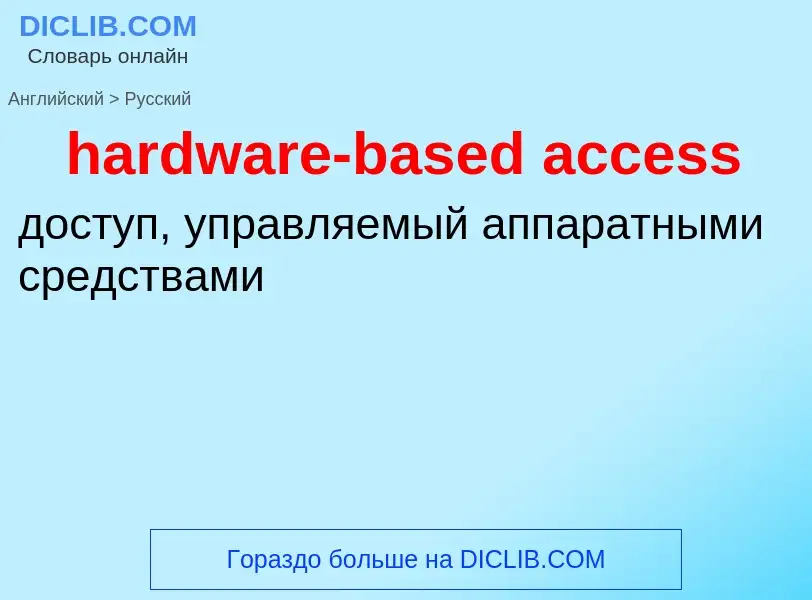Перевод и анализ слов искусственным интеллектом ChatGPT
На этой странице Вы можете получить подробный анализ слова или словосочетания, произведенный с помощью лучшей на сегодняшний день технологии искусственного интеллекта:
- как употребляется слово
- частота употребления
- используется оно чаще в устной или письменной речи
- варианты перевода слова
- примеры употребления (несколько фраз с переводом)
- этимология
hardware-based access - перевод на русский
['hɑ:dweə]
общая лексика
аппаратные средства, аппаратура, оборудование, редко аппаратное обеспечение
общее обозначение совокупности физических устройств компьютера или отдельных его частей, включая периферию, в отличие от программ и данных. Например, hardware vendors - поставщики аппаратных средств. Деление на ПО и аппаратные средства до известной степени условно - большинство аппаратных функций может быть реализовано программно и наоборот. Решение о том, что реализовывать программно, а что аппаратно, зависит от требуемого быстродействия, надёжности, частоты ожидаемых изменений и других факторов
аппаратный
агрегаты
аппаратное обеспечение
аппаратное оборудование
арматура
комплекс технических средств
крепежный
метизный
техническое обеспечение
ортопедия
металлоконструкции
строительное дело
металлические изделия
технические средства (приспособления, устройства)
аппаратура, аппаратные средства
нефтегазовая промышленность
аппаратура
оборудование
синоним
существительное
общая лексика
скобяные изделия
металлоизделия
метизы
металлические изделия
скобяные товары
вычислительная техника
аппаратное
техническое обеспечение или оснащение (в отличие от программного)
элементы электронных устройств
«хардвер»
«железки»
техника
механическая конструкция
арматура
аппаратное оборудование
приборы (магнитофоны, телевизоры)
военное дело
материальная часть
боеприпасы
оружие
вооружение
шутливое выражение
ордена
медали
нагрудные знаки
знаки отличия
«побрякушки»
сленг
спиртной напиток
- computer hardware
- cryptographic hardware
- dedicated hardware
- duplicate hardware
- enciphering hardware
- encryption hardware
- intelligence hardware
- protection hardware
- secure hardware
- security hardware
- special-purpose hardware
- tamper resistant hardware
- wireless hardware
2) аппаратура, аппаратное оборудование (ЭВМ)
3) скобяные товары
4) технические средства; оснастка
5) техническое обеспечение АСУ и АОД
- brassboard hardware
Определение
.
Википедия
Attribute-based access control (ABAC), also known as policy-based access control for IAM, defines an access control paradigm whereby a subject's authorization to perform a set of operations is determined by evaluating attributes associated with the subject, object, requested operations, and, in some cases, environment attributes.
ABAC is a method of implementing access control policies that is highly adaptable and can be customized using a wide range of attributes, making it suitable for use in distributed or rapidly changing environments. The only limitations on the policies that can be implemented with ABAC are the capabilities of the computational language and the availability of relevant attributes. ABAC policy rules are generated as Boolean functions of the subject's attributes, the object's attributes, and the environment attributes.
Unlike role-based access control (RBAC), which defines roles that carry a specific set of privileges associated with them and to which subjects are assigned, ABAC can express complex rule sets that can evaluate many different attributes. Through defining consistent subject and object attributes into security policies, ABAC eliminates the need for explicit authorizations to individuals’ subjects needed in a non-ABAC access method, reducing the complexity of managing access lists and groups.
Attribute values can be set-valued or atomic-valued. Set-valued attributes contain more than one atomic value. Examples are role and project. Atomic-valued attributes contain only one atomic value. Examples are clearance and sensitivity. Attributes can be compared to static values or to one another, thus enabling relation-based access control.
Although the concept itself existed for many years, ABAC is considered a "next generation" authorization model because it provides dynamic, context-aware and risk-intelligent access control to resources allowing access control policies that include specific attributes from many different information systems to be defined to resolve an authorization and achieve an efficient regulatory compliance, allowing enterprises flexibility in their implementations based on their existing infrastructures.
Attribute-based access control is sometimes referred to as policy-based access control (PBAC) or claims-based access control (CBAC), which is a Microsoft-specific term. The key standards that implement ABAC are XACML and ALFA (XACML).

